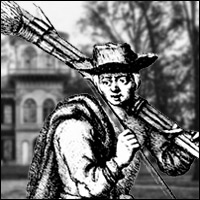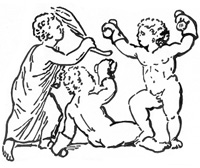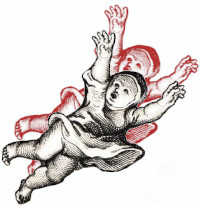1980, Oxford, NY, 270 pages
Review Focus
Looking Out For Number One: The Cultural Limits on Public Policy in Early Virginia
A Changing Labor Force, Race Relations in Virginia, 1660-1710
Horses and Gentlemen: the Cultural Significance of Gambling Among the Gentry of Virginia
Of Time and Nature: A Study of Persistent Values in Colonial Virginia
Overview
This incredibly dense and well-researched little book begins with five essays on the settlement of New England, with little care taken to determine the identity and plight of the servant class. There is a statement that only 2% of white slaves were shipped to New England. The view of New England is not what we see in Peter Williamson’s account, but is insightful. I particularly recommend the end notes. Where the author really shines in this section is in his examination of living conditions for common folks in Rural England, who had to put up with “soldiers” “billeting” among them, which meant killing live stock, beating fathers and raping daughters and wives, and even killing constables who tried to enforce law and order. The English monarch’s desire to have a standing army and not pay for it was one of the terrible aspects of life in England, and explains why colonists of all stripes did not want troops stationed in their communities.
The author’s overall thesis seems to be that the Virginian love of “liberty” was doomed to cause a corrupt system, where the Puritan obedience to community would eventually win out. However, nowhere does a Virginia planter discuss liberty as anything other than the latitude to exploit less powerful humans at will with the full support of the government.
A Hell Called Virginia
The balance of the book was an attempt to support standard revisionist American historical assumptions about the composition of the laboring classes of Colonial Virginia. Unfortunately, the author continually had to admit that white slaves and black slaves essentially suffered the same cruelties. His work on Bacon’s Rebellion is excellent—the best I have read. He lets the early Jamestown writers speak for themselves. Later on, as complaints are referenced by white slaves, which indicated that they were pure chattel, he would cite an opposite claim by a government official stating that servitude was a glowing opportunity for self-improvement. It is only natural for the historian to side with the literate class.
Breen’s research into Virginia history reveals that it was a pure slave colony. He does not pick up on numerous points, blinded as he is by convention.
For instance, Indians that were allied with the governor against the poor whites and supplied with weapons were described as “innocent” victims of the poor whites who wiped them out when they rebelled under Bacon in1676. There is one letter home from a servant boy who describes the Indians as being indistinguishable from other Englishmen until they attack, and then refers to them as “rogues,” which was a term used to described English criminals. While Breen is castigating the Virginia planters for living in a dispersed fashion, he overlooks the very identity and composition of the Indian force, which was only part Indian!
In Bacon’s Rebellion, Breen’s liberal gravity at last comes into sync with events and he is able to cite examples of black and white slaves banding together and fighting rich whites until screwed by military intervention, including a Pirate captain who tricked the last 100 blacks and 20 whites into surrendering with false promises. Then, with the end of Bacon’s Rebellion and new humane legislation by King Charles II, Breen is able to report that all whites are now on the same team and the blacks are the sole sufferers. To a large extent he does prove this case, noting that small scale slave owners were moving their operations out of Virginia to Maryland and Pennsylvania, where English servitude would be focused until the Revolution, and where Peter would be caught in its cruel grasp. Breen lets the slaughter and removal of the Virginia Indians pass with barely a word, not really understanding their earlier relationship to master and servant.
Like many a good modern scholar the author provides ample documentation to refute his own conclusions, such that whites were no longer held in bondage in Virginia after 1710. Despite his insistence that whites were servants and blacks were slaves and that there was a difference, his own quotations of sources prove that this revisionist convention is utterly false. He vaguely describes how the poor white servants and black servants were separated and played off against each other, and notes that the blacks could never successfully rise without the aid of the poor whites, citing cavalry as the key to this stabilization, without noting the land clearance that enabled the cavalry to operate.
Finally, on page 145, Breen is able to croon the revisionist song, citing an incident in which 100 African slaves out of 330 had died crossing the Atlantic, and waxing righteous,“No white servant of this period, no matter how poor, how bitter or badly treated, could identify with these frightened Africans.”
If the author would have cared to investigate, he would have found that a ship in this very same decade [1680s], carrying 100 white children, threw 51 overboard during the crossing, or that the worst was yet to come, with a Pennsylvania Island being turned into a carnal house for dead and dying slave children in the 1730s. Indeed, one might wonder if the white slaves could identify with the black servants, since most of the whites were children and most of the blacks were adults.
The cases made by revisionist establishment historians like Breen, or of heretical researchers into white slavery like Hoffman, that one group had a worst kind of hell than the other, is beside the point. As Breen amply demonstrates with his research, wherever Englishmen planted a colony, slavery immediately took hold in its cruelest sustainable form, and held onto the vast majority of the souls dammed to this existence until they were beaten to death, worked to death, starved to death or slain while escaping or rebelling.
No doubt, T. H. Breen would be horrified that his densely researched, off focus and honestly translucent work is one of the primary sources for Stillbirth of A Nation.











